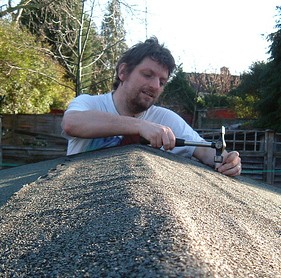Building Your Novel with a Holistic Approach
We’ve spent a whole year looking at the twelve pillars of novel construction, and I hope you’ve gained a lot of great, new insights on how to “build” a novel. I want to take a little time to go over some points about construction that I hope will stick with you through the years as you write your many novels.
There are plenty of books that teach novel writing. I probably have most of them in my library, and there are some great ones, to be sure. What prompted me to put this material together for my blog (and which I’m now compiling and expanding to release as a book in a few months as part of my Writer’s Toolbox Series) is that, despite all the great writing craft books available, many writers are struggling with novel structure.
I critique and edit more than two hundred partial and complete manuscripts a year. Year after year, I see struggling writers making the same fatal mistakes in their manuscripts. Even those writers who have studied the best novel-writing instruction books and have followed writers’ blogs and have taken numerous workshops still don’t get the structure.
Why Bother with Structure?
Is structure important? Do I think novelists have to follow very specific structural rules to write a great novel? Yes and yes. When I first started writing novels, I thought I could wing it. I’d read plenty of various genres all my life, so in a way, I felt that made me an expert. I assumed that by osmosis I’d learned how to write well. And that was true—to a point.
Truth is, a lot of writers believe they can write a novel without taking time to learn the nuts and bolts of novel construction. I wonder why this is. I doubt many aspiring doctors or dentists or lawyers believe they can jump into their practice by just reading a few books, or maybe even by watching some TV shows. I certainly wouldn’t want to learn that my surgeon hadn’t graduated medical school or read Gray’s Anatomy as I’m being wheeled on a gurney into the operating arena.
Novel Writing Is Not Easy
Writing a novel may not be as complex as performing an operation on someone, but it does have its complexities. Just as with building a house—which is what we examined deeply in this course—writers have to adeptly wield not only a whole lot of materials but a lot of tools as well. For every task in building a house, a builder must know both his materials and his tools. You don’t frame up a house with tarpaper, and you don’t use plastic pipe for gas lines. It takes time and effort to acquire the proper training to be proficient in any vocation. Novel writing is no exception.
I will venture to say that at least 80-90 percent of the novels I critique are seriously flawed in structure. Some so much so that they really need to be round-filed. I cringe hearing how some of these writers have spent years penning their first novel (or perhaps many subsequent ones), and often have spent additional years trying to get an agent to sign them. These are wasted years. Sure, all that effort may have been a good learning experience—to a point. But I liken this to someone without any training being given a thousand car parts and then told to put it all together (maybe with a four-page diagram) and end up with a perfectly operational and beautiful vehicle. It’ll never fly (or drive).
Some of the above-mentioned writers actually do spend hard hours studying novel structure. They buy the best books, attend workshops and conferences, hire editors, and join critique groups. But they still suffer novel failure. Over and over I see the same essential problems plaguing manuscripts. So what is the problem? Are they just not trying hard enough? Can only the smartest, most talented people write great novels?
There Are Lots of Books, but . . .
No, I don’t believe that. I believe just about anyone with the determination, a love of storytelling, a good imagination, a firm handle on language and composition, and a jar of “butt glue” (to keep one stuck in that chair and writing) can write a great novel.
But I also feel there is a dearth of how-to books that really address the key problems new novelists face and find daunting. Aspiring novelists can find hundreds of books that will teach them tips on how to write a great plot, develop believable characters, and craft catchy dialog. There are books that focus on just about every novel component, and writers could spend years studying these books and still not really grasp how to construct a novel. Why? Because so much of what is taught is about the tools of the trade, but not so much about how to construct the entire “house.”
Think Holistically
Just as building a house is a very complex undertaking, building a novel requires a similar holistic approach. When a builder looks at blueprints, he sees “the big picture.” He has to understand every single aspect of the process and think ten steps ahead (that’s how my builder husband puts it). When he looks at the foundation blueprints, he envisions how this will affect the task of hanging joists and laying out the roofline. When studying the details for the concrete forms, he’ll check the rebar specs to make sure they are going to be the right thickness to support that second story extension.
That house will never be built right if the builder only tackles one task myopically at a time. Every step of the way, he must keep in mind the finished product and how it is slated to look. He has to consider how every single part of this construction process affects and informs all the others. It’s like seeing the forest and not just all the individual trees.
And this is exactly what a novelist must do as well, and what few (if any) writing craft books teach. For a writer to write a great novel that is constructed soundly, she must work with the “big picture.” All the elements in a novel—plot, premise, theme, characters, etc.—must work holistically, and fit together perfectly. Too often writers throw a bunch of materials together and grab random tools they little know how to use and get hammering. The result is usually a disaster. What is most painful is when the foundation is seriously flawed—meaning the core concept itself just doesn’t hold together. For then, everything that is built upon such a foundation cannot stand. The house will collapse. The novel will fail.
Just Writing Won’t Cut It
Writing a novel is not easy, despite what some say (and usually it’s the people who have never written one who say that). And practice does not make perfect. If you keep practicing your musical scales using improper technique and poor hand position, you will enforce bad habits and keep playing them badly. Writing a lot of words or participating in NaNoWriMo (writing a novel in one month) can help writers with discipline and stick-to-itiveness, but without getting a grip on proper novel construction, writers won’t write great novels. They may have a lot pages to show for their effort, but in some ways (okay, shoot me) it’s wasted effort. Getting into the habit of writing daily, or learning how to push yourself to meet deadlines—those are good things. But they will not help you write a great novel.
So, my aim with this course was to get right to the essentials of how to wield the tools and materials of novel construction as well as teach you how to look at your story holistically. Instead of learning one novel component at a time, disconnected to any other components, I’ve tried to help you think in terms of building all your support pillars together and in a way that they work together to hold up your story.
I’ll go more into review on this in next week’s post, but I’d love to hear your comments. What pillar of construction do you struggle most with? Are there any that you hadn’t really understood but now have learned ways to use them constructively in your story? Share some thoughts on how this course has helped your novel.
Have you printed out all your inspection checklists yet? Be sure to do so, and use them for every novel you work on. These 144 sets of questions will help you examine the structure of your key pillars and (I hope) prevent you from novel failure!
Inspection Checklist 1-concept with a kicker
Inspection Checklist 2-protagonist with a goal
Inspection Checklist 3-conflict with high stakes
Inspection Checklist 4-theme with a heart
Inspection Checklist 5-Plots and Subplots in a String of Scenes
Inspection Checklist 6-Secondary Characters with Their Own Needs
Inspection Checklist 7-Setting with a Purpose
Inspection Checklist 8-Tension Ramped to the Max
Inspection Checklist 9-Dialog Compressed and Essential
Inspection Checklist 10-Voice Unique for Each Character
Inspection Checklist 11-Writing Style Concise and Specific
Inspection Checklist 12-Motifs for Cohesion and Depth
Photo Credit: Kaptain Kobold via Compfight cc












Your Pillars of Novel Construction series and related checklists are invaluable tools for novelists. Thank you for sharing them.
The most challenging pillar for me is creating conflict that is seemingly unresolvable and then (hopefully) having the protagonist deal with it in a surprising or unconventional way.
Thanks for the kind words. I’ll be putting the book out in March, and I’ve added a huge amount of information and examples particularly regarding the concept with a kicker and Conflict with High Stakes. I’m also going to be pairing it with a workbook so it will help get those ideas worked out. Thanks for joining in on this course all year!
The two pillars that helped me the most were your discussion of secondary characters and motifs. The neat thing is that creating goals for a broader set of characters gave me opportunities to create more meaningful conflict for my protagonist and raise the tension in a lot of scenes. I’ve come up with a motif that helped me condense some wandering scenes and toss out some that were irrelevant. The process really is holistic; and if you keep your eyes open, when you improve one pillar, you’ll see opportunities to strengthen others. Thank you so much for this blog.
The 144 questions are so insightful, it’s difficult to identify the best, the most fulfilling category. The one that triggered questions to me about what needs attention in my novel is making certain that the protaganist is not perfect. Another was the editng process of removing attributions from dialogue, and replacing with pointed, important, actions within the character. I recently purchased Say What, and Writing the Heart of Your Story. I commend you for those two, and am awaiting your book in March. Your blog is so valuable to me. Thank you, Ms. Lakin.
Thanks so much, Bob! I appreciate you sharing what’s helped you. I’ve added a ton of extra material in the book and will get started soon on the workbook so I can release them both together (aiming for March 1). I hope my other books help you learn to write great novels! The blog is a lot of work and a labor of love, so it’s encouraging to me to hear words like these to keep me going! Merry Xmas!
Added: Obviously, I should have proofread my above reply to correct the misspelling of protagonist, and the typographical error: awaiting.
I have thoroughly enjoyed this year’s posts on the pillars, and am looking forward to the book. This has been a wonderful series. If only I could put it all into practice! Thank you so very much.
You can! Thank you!
Thanks for all your effort in putting this course together, and I will certainly be sharing the book’s release with the group of new authors I’ve started working with – I think most of them could do with reading it!
For me, most of this information wasn’t new, but I love the way you’ve structured it, making it easy to pick my current WIP apart and touch it up here and there. The best part for me was the last: motifs. I’ve never included any motifs in a deliberately fashion before, but your examples made the reasons for their use so clear I shall be doing so from now on.
Thanks again for a great course.
Thanks, Deborah. It’s been a lot of fun and a challenge for me. There isn’t a lot of “new” information as far as teaching how to write a novel. It’s mostly about perspective and how to go about such a huge task. I think a big challenge is what to do with all the skills and understanding a writer accumulates. How do you take this massive amount of info and turn it into a method that makes tackling plotting and writing a novel undaunting. That’s been my aim, and I’m excited about putting out the book and workbook in March, for I think it will help a lot of struggling authors finally have a system that will help them target the components that are weak or missing from their stories. Thanks for coming along on the journey and sharing comments!
Thank you for all of your hard work and your generosity for sharing so freely. I am looking forward to your book. I had no idea about consciously using motifs until I read about them here and then thought ‘of course’. Much like after I read the other pillars – so obvious when someone points it out to you. I have recommended your site to my writers’ group and the checklists provide great discussion points. I wish I could find someone who can be as insightful in the non-fiction arena for some of our group members who do not write fiction. I have read your blogs and articles for a few years now and put them on my ‘favourites’ menu almost at once. Thanks again.
Thanks, Kelly. I can help those nonfiction writers! There are also lots of great blogs and NF writers, like Nina Amir (who has Write Nonfiction now blog). Glad my material has helped you write! What are you working on?
Thanks for a year of great and sound ideas. You have nailed it–pun intended. Novel writing is hard work and truly every sentence should be part of the significant whole. I have benefitted from reading your posts and want to say again THANK YOU. Beth Havey
Thanks, Beth! It’s been a very challenging year for me writing these posts and checklists, and I’ve just now finished compiling it all into a book, and added a lot more examples and explanations. Next, the workbook. They’ll both be published March 1 (or that’s my goal). Next year’s course is going to be really awesome, as I have four terrific editor/novelists who are going to tackle the fatal flaws of fiction writing, and every post will have before and after examples. which will really help writers catch bad writing!
Well writ! This is a well-composed and helpful piece of work. While currently in the mud of a serious novel, these posts are encouraging to me.
Sincerely,
B. Tyler Lowe
Thank you and glad they’re helping!
Wow. These checklists are pure gold. You are so generous! Thank you!
You’re welcome! The workbook has hundreds of brainstorming questions and examples, so if you want to go deeper, that’s the ticket!
I have thoroughly enjoyed this posts on the pillars. i think your book is out now! and you surely getting so good response to it…..
I literally cried a couple of times through this course, and feel like I might one more time because I just am soooo thankful for all I’ve learned. It was hard at times, my head literally hurt over all I was learning this past month, but I couldn’t stop reading, there is so much to learn. I’ve been writing for 20 years, but just novels that I like to read myself. My last one 3 people ended up reading, and asked me, begged me, to publish it. But I knew it wasn’t good enough. I knew I head hopped, though I didn’t know the term, and things like that. I have learned that I had a few of the pillars down really well, like tension, theme, and motif, and others I had down really poorly like I think my voice, though different, was not different enough for each character, my settings were often home, work, or… yep, restaurants and a church banquet. I have learned so much, and talked my husband’s ear off a good dozen times or more while I needed to process new ideas that just floored me and made me so excited. I can’t say thank you enough for how much I’ve learned, I am finally feeling equipped to go back to my last novel and just tear into it, and then maybe publish it like my loved ones are begging me to. I now have 25 pages of notes and checklists so that I can refresh with every single novel until I get this down right in my head. 🙂 From the bottom of my heart, a million times over, THANK YOU!
My MIL knows money is tight right now with several things needing attention all at once in our lives, so she gave me some money to get three of your books when I kept talking about all I was learning in this course. Going to spend some time this weekend pouring over the seven writing crafts books you have on Amazon and picking the three out. 🙂 Will be so glad to finally own some of your works! Especially since I have learned so much. Thank you for all you do for us. It is so appreciated.